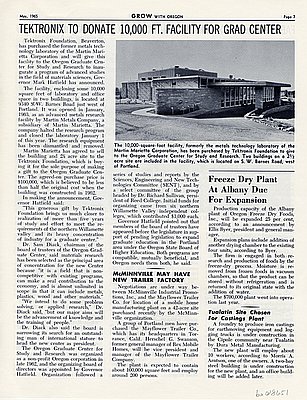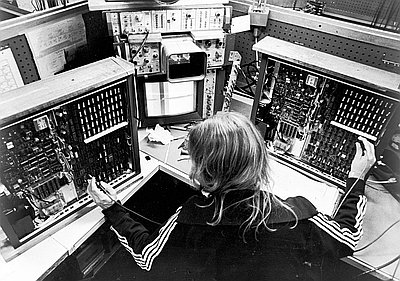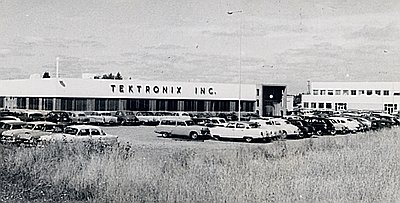- Catalog No. —
- ba018636
- Date —
- October 1962
- Era —
- 1950-1980 (New Economy, Civil Rights, and Environmentalism)
- Themes —
- Education, Science, Medicine, and Technology, Trade, Business, Industry, and the Economy
- Credits —
- Grow with Oregon, OR Ex/EC7 .3G91, Oregon Historical Society Research Library
- Regions —
- Portland Metropolitan
- Author —
- State of Oregon, Department of Planning and Development
Sunset Science Park
This 1962 aerial photograph depicts a section of Beaverton bordered by the Sunset Highway between Cornell and Murray roads. The cluster of buildings near the center of the photograph is Sunset High School. The photograph appeared in a state publication, Grow with Oregon. The accompanying article announced a groundbreaking ceremony for Sunset Science Park. Broken white lines on the photograph highlight the construction site.
Electro Scientific Industries (ESI), a well established Portland manufacturer of high-precision electronic equipment, purchased the one-hundred-acre site to build an industrial park modeled after Science Park near Stanford University in California. The idea was to attract science-oriented manufacturing industries interested in research and development by creating a complex that resembled a college campus.
Many local citizens did not initially approve of the park - which was designed to house the clean plants of light industry - because they associated all industry with dirty smokestacks. The site's proximity to schools, recreation centers, and housing developments concerned them. Support of the project by Governor Mark Hatfield helped ESI officials win over the community.
ESI's move to the science park resulted from the company's steady growth since its beginning as Brown Engineering Company, which had manufactured impedance bridges during World War II. Impedance bridges, devices that measure alternating-current resistance in electrical equipment, continued to be the company's primary product after Douglas Strain, a partner, purchased the company with his father in 1953 and changed its name to ESI.
The U.S. Department of Defense was ESI's primary customer in 1953, but product diversification eventually brought others, such as the National Aeronautics and Space Administration (NASA) and the Boeing Company. After Russian technology sent the first artificial satellite (Sputnik) into space in 1957, the U.S. government sought to compete, creating more business for ESI - including a significant contract with the U.S. Army.
By 1966, all ESI operations had relocated to Sunset Park. The company's successes vastly increased during the 1970s and 1980s, when it became one of the first companies nationwide to use lasers to manufacture integrated electronic microcircuits. The laser apparatus ESI designed in 1976 launched the company into unprecedented financial success, as the device became an essential tool for nearly every microcircuit manufacturer in the world. Still located at Sunset Park, ESI is distinguished as the oldest company within the cluster of high-technology firms in and around Portland known as Oregon's Silicon Forest.
Further reading:
Dodds, Gordon B. and Craig E. Wollner. The Silicon Forest: High Tech in the Portland Area 1945-1986. Portland, Oregon: Oregon Historical Society Press, 1990.
Written Sara Paulson, © Oregon Historical Society, 2007.
Related Historical Records
-
Tektronix to Donate 10,000 Ft. Facility for Grad Center
This article and photograph appeared in the May 1965 issue of Grow with Oregon, a state publication of the Planning and Development Division. The article describes progress toward …

-
Tektronix Oscilloscope
This photograph depicts a Tektronix employee studying an invention by the company--a storage oscilloscope. The Washington County high-technology firm's new products recorded faster electronic signals than other oscilloscopes …

-
Tektronix's Sunset Plant
This photograph depicts Tektronix's plant at Sunset Highway and Barnes Road. The oscilloscope manufacturer moved to this new, state-of-the-art facility in 1951, having outgrown its plant on Hawthorne …

